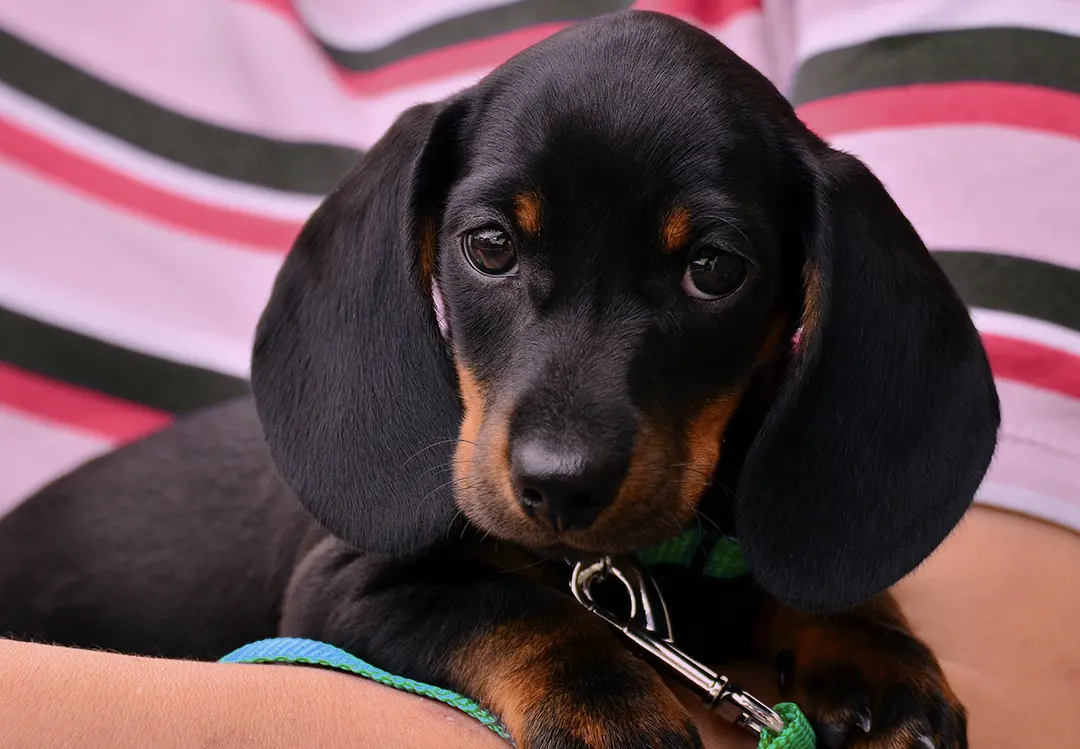Have a new puppy? Feeling a bit overwhelmed? You’re not alone.
It’s okay to feel this way. And believe it or not, the secret to a lifetime of friendship with your dog is often hidden in those first few weeks at home.
Think of it like this: your puppy is a blank slate, full of potential to become a wonderful companion. These early days are about more than just teaching “sit” or “stay”; you’re building the foundation for a lifetime of good behavior.
We know it can feel like a lot to handle, especially with a lively puppy. That’s where a great puppy training guide comes in. It’s your friendly companion for this journey, helping you and your furry friend master commands, learn tricks, and build a strong bond. It’s a rewarding adventure for both of you! 🐾
Let’s explore why starting early isn’t just a good idea—it’s absolutely essential! 🚀🐶
Why Early Puppy Training is Essential
1. Puppy training unlocks communication channel with your dog
Ever found yourself saying, “If only my dog could talk”? Well, puppy training is the closest thing to having a conversation with your furry friend. It’s a two-way street where you learn to understand each other. Through commands, gestures, and positive reinforcement, you’re creating a language that strengthens the bond between you and your pup. This clear communication makes daily life smoother and more enjoyable for both of you.
2. Training instills crucial safety commands for your pups
Imagine a world where your pup doesn’t bolt towards the open door or dash across the street at the sight of a squirrel. Training helps instill crucial safety commands like “sit,” “stay,” and “come.” These commands are not just nifty tricks; they’re your furry friend’s passport to a safe and secure environment. Training builds a reliable foundation that keeps your pup out of harm’s way.
3. Good Manners Make Good Dogs
Nobody likes a furry tornado that leaves a trail of chewed shoes and shredded pillows. Puppy training is like etiquette school for your four-legged companion. Basic puppy behavior training such as not jumping on people, not biting, and waiting patiently for meals ensures that your pup is not just cute but well-behaved too. It’s the key to having a happy coexistence, whether you’re hosting guests or enjoying a quiet night in.
4. Well trained puppy a joy to be around
A well-trained pup is a joy to be around. When your dog understands the rules and knows how to behave, it reduces stress for both of you. You’ll find yourself relishing in the joys of companionship without the headaches of constant misbehavior.
5. Training stimulates puppy confidence and independence
Just like humans, dogs thrive on a sense of accomplishment. Training provides mental stimulation and challenges that boost your pup’s confidence. As they master new commands and tricks, they become more self-assured and less prone to anxiety. A well-trained dog is a happy and independent one, ready to take on the world with a wagging tail.
Puppy Training 101
When it comes to puppy training, there’s a variety of puppy training techniques, and the one that works best often depends on your puppy’s personality, your lifestyle, and your training goals. It’s essential to keep in mind that:
Consistency plays a pivotal role in any puppy training method. Having consistent rules and commands throughout your home ensures your puppy isn’t puzzled by conflicting signals. It’s crucial for everyone involved in your puppy’s care to be on the same page regarding expectations and commands.
Training is a gradual process, and puppies might not grasp it immediately. Patience is key for successful training. Celebrating small victories, maintaining a positive attitude, and recognizing that setbacks are a natural part of the learning journey all contribute to a successful training experience.
Now, let’s explore some popular and positive methods for training your adorable friend:
1. How to Housebreak a Puppy
Puppy housebreaking, encompassing both traditional potty training and the use of puppy training pads. It focuses on instilling cleanliness by establishing designated areas for your puppy’s bathroom needs. Whether you’re aiming for outdoor potty training or opting for the convenience of indoor pad training, the overarching goal remains the same: to guide your puppy in developing habits that contribute to a happy and well-behaved coexistence.
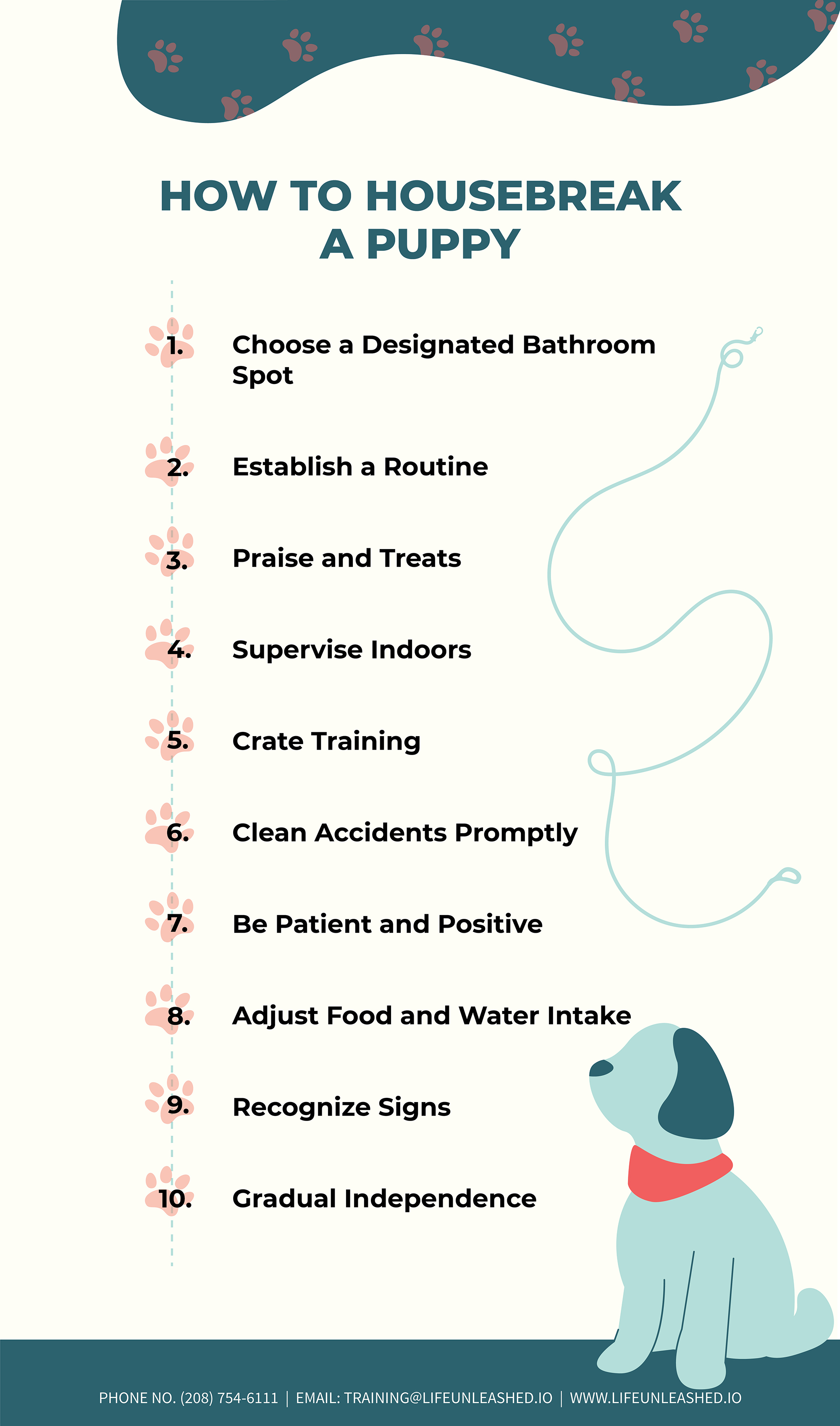
Now, let’s dive into how you can effectively house train your puppy:
1. Choose a Designated Bathroom Spot: Choose a specific spot for bathroom breaks. If you’re doing pad training, this spot could be a bathroom, laundry room, or any room where your puppy can move freely. If you’re potty training your puppy for outdoor, pick a corner in your yard or a nearby park. Being consistent with the location is crucial because the scent in that spot will help your puppy connect it with the need to answer the call of nature.
2. Establish a Routine: Create a consistent schedule for bathroom breaks. Puppies thrive on routine, so take them to the designated bathroom spot after waking up, after meals, and before bedtime. This helps them understand when and where to do their business.
3. Praise and Treats: Celebrate victories! When your puppy does their business in the designated area, shower them with praise and treats. Positive reinforcement creates a positive association with successful bathroom breaks.
4. Supervise Indoors: Keep a watchful eye on your puppy indoors, especially when they’re not yet fully house trained. If you catch them in the act of going where they shouldn’t, calmly take them to the designated spot.
5. Crate Training Your Puppy: Utilize crate training to your advantage. Dogs are less likely to eliminate in their own space, making the crate an excellent tool for reinforcing good bathroom behavior.
6. Clean Accidents Promptly: Accidents happen, and when they do, clean up promptly using an enzymatic cleaner. Thorough cleaning removes scent markers, reducing the likelihood of repeat offenses in the same spot.
7. Be Patient and Positive: Puppies are learning, and accidents are part of the process. Be patient and avoid punishment. Positive reinforcement for good behavior is much more effective than scolding for accidents.
8. Adjust Food and Water Intake: Monitor your puppy’s food and water intake, adjusting the timing to make bathroom breaks more predictable. This helps in preventing accidents caused by sudden urges.
9. Recognize Signs: Learn your puppy’s cues for needing to go—sniffing, circling, or whining. Anticipating their needs helps in avoiding accidents and reinforces the connection between signs and outdoor breaks.
10. Gradual Independence: As your puppy becomes more reliable with potty training, gradually give them more freedom indoors. Reinforce good behavior consistently, and reward them for consistently using the designated spot.
2. How to Crate Train Your Puppy
Crate training is like giving your puppy their cozy little den—a safe and secure space they can call their own. Imagine it as a puppy sanctuary, a bit like their bedroom, where they can chill, nap, and feel totally at ease.
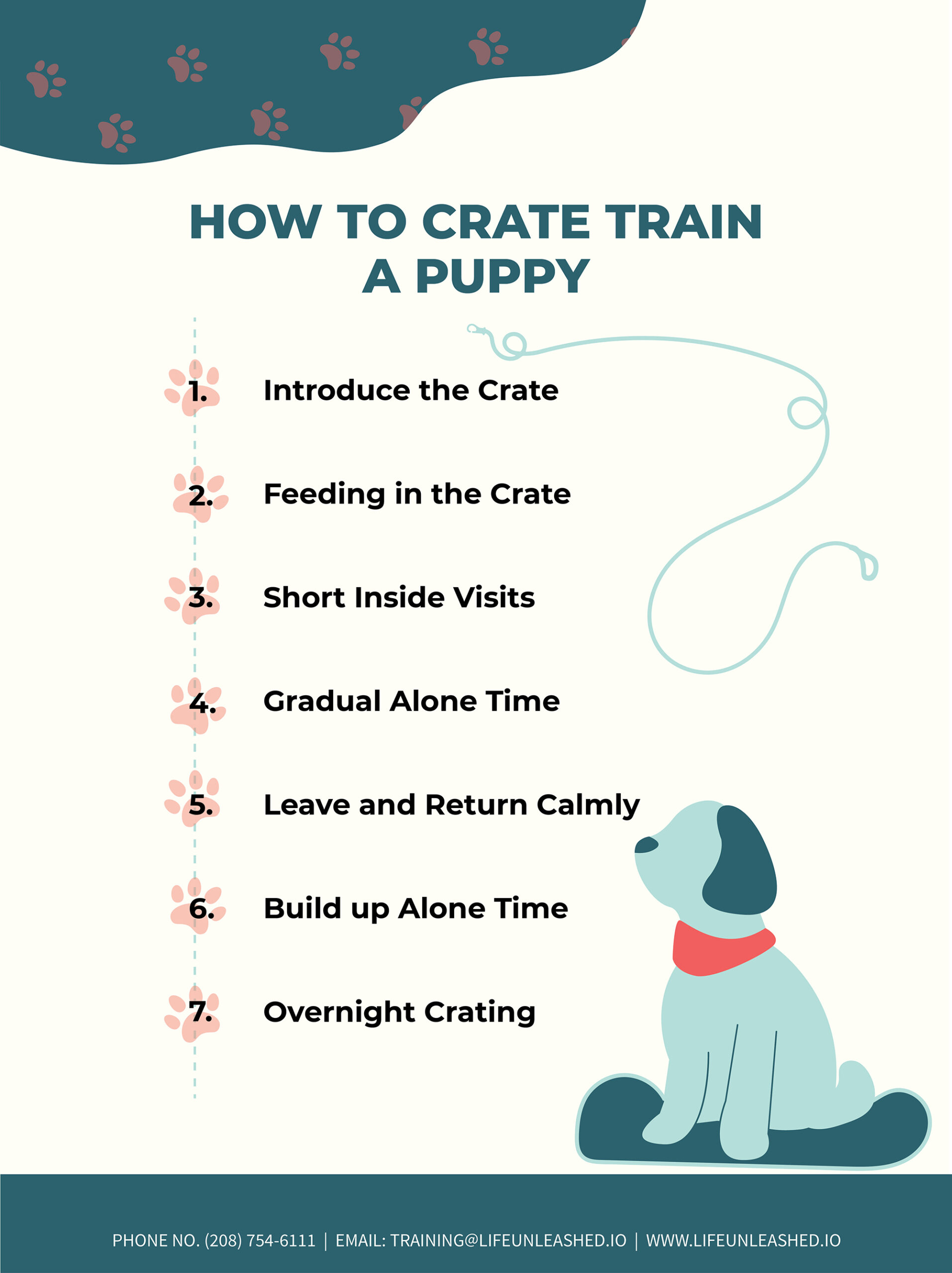
Let’s break down crate training into simple steps:
1.Introduce the Crate: Start by making the crate a fun and positive place. Leave the door open and let your puppy explore it at their own pace. Toss in some treats and toys to create a positive association.
2. Feeding in the Crate: During mealtime, place your puppy’s food bowl near the crate, then gradually move it inside. This helps them see the crate as a place for good things, like yummy meals.
3. Short Inside Visits: Encourage your puppy to go into the crate and reward them with treats. Close the door for short periods while you’re right there. Open it once they’re calm, so they understand that being inside is okay.
4. Gradual Alone Time: Once your pup is comfortable with short stays, gradually increase the time they spend inside the crate while you’re around. This helps them feel secure even when alone.
5. Leave and Return Calmly: Practice leaving the room or house for short intervals. Keep arrivals low-key to avoid creating anxiety. This helps your puppy associate your leaving and returning with normal, non-stressful events.
6. Build up Alone Time: Slowly extend the time your puppy spends alone in the crate. Continue rewarding good behavior and staying calm. The goal is to make being in the crate a positive experience.
7. Overnight Crating: When your pup is comfortable spending time alone, you can try crating them overnight. Place the crate in your bedroom initially, so they feel reassured by your presence.
Remember, crate training is about creating a positive and safe space for your puppy.
3. Basic Commands to Teach Your New Puppy
Teaching basic commands such as sit, stay, come, and lie down forms the foundation of puppy training. We cover this on our pdf freebie, sign up to get your copy. Utilizing treats, praise, or a combination of both, you can reinforce these commands. Starting with short sessions and gradually increasing the complexity of commands allows for a positive and gradual learning experience for your puppy.
4. How to Clicker Train Your Puppy
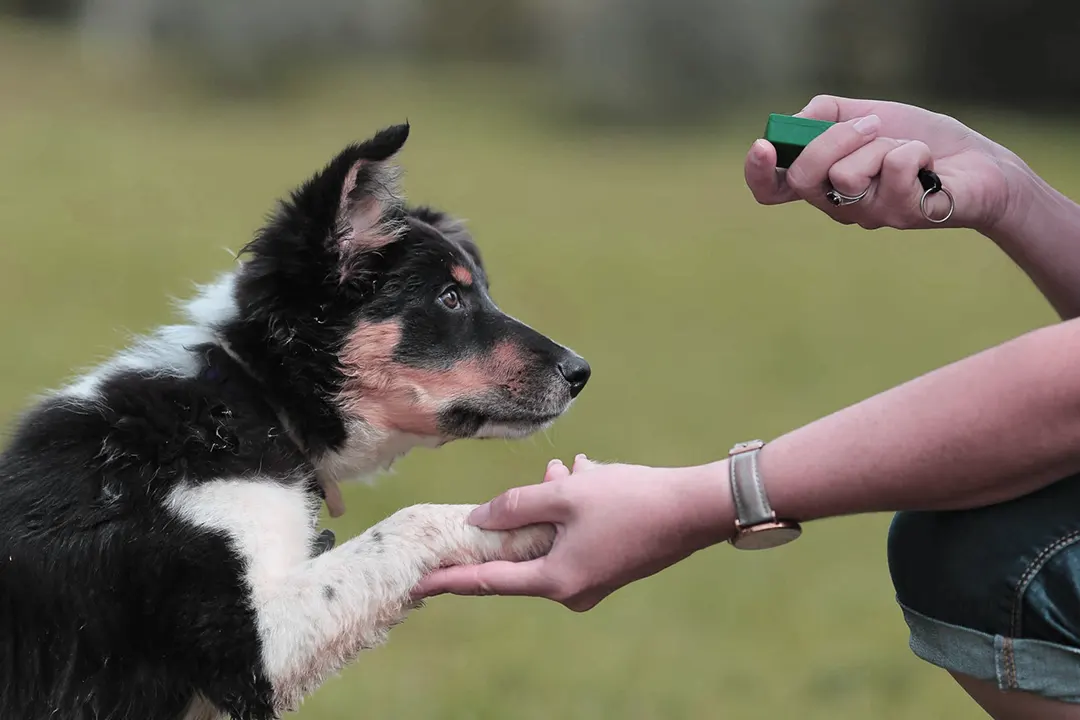
Another effective method is clicker training. This is a positive reinforcement method widely used in puppy training and dog obedience. It’s a popular and effective technique that relies on associating a distinct sound, typically a “click” from a handheld device called a clicker, with a reward to reinforce desired behaviors.

Here’s how clicker training typically works:
1. Association: The first step is to teach your puppy to associate the sound of the clicker with a reward. This is usually done by clicking and immediately offering a treat. Repeat this process until your puppy makes the connection between the click and the treat.
2. Timing is Crucial: The click must be timed precisely to mark the desired behavior. It acts as a communication tool, letting your puppy know exactly what they did right. For example, if you’re teaching them to sit, you click the moment their bottom touches the ground.
3. Reward-Based: Clicker training is fundamentally based on positive reinforcement. The click itself doesn’t provide the reward; it’s a signal that a reward is coming. This makes the training experience enjoyable for your puppy, as they learn to associate the click with something positive.
4. Consistency: Like any training method, consistency is crucial. Always follow the click with a reward, and be consistent in your use of the clicker. This helps your puppy understand the connection between their behavior and the reward.
5. Versatility: Clicker training can be used to teach a wide range of behaviors, from basic commands like sit and stay to more complex tricks. The clarity of the click as a marker makes it a versatile tool in shaping various behaviors.
6. Reduced Verbal Commands: Clicker training allows you to communicate with your puppy without relying heavily on verbal commands. This can be especially useful for puppies who may not fully understand spoken language yet.
7. Encourages Thinking: Clicker training engages your puppy’s brain as they learn to figure out which behaviors earn them the click and the subsequent reward. It encourages them to think and participate actively in the training process.
Remember, while clicker training is a powerful tool, it works best when combined with other positive reinforcement techniques. It’s essential to create a well-rounded training approach that considers your puppy’s individual needs, strengths, and personality.
5. How to Successfully Socialize Your Puppy
Socialization is a crucial aspect of puppy training that involves exposing your puppy to a variety of experiences, people, places, and other animals in a positive and controlled manner. The goal of socialization is to help puppies develop into well-adjusted, confident, and friendly adult dogs.
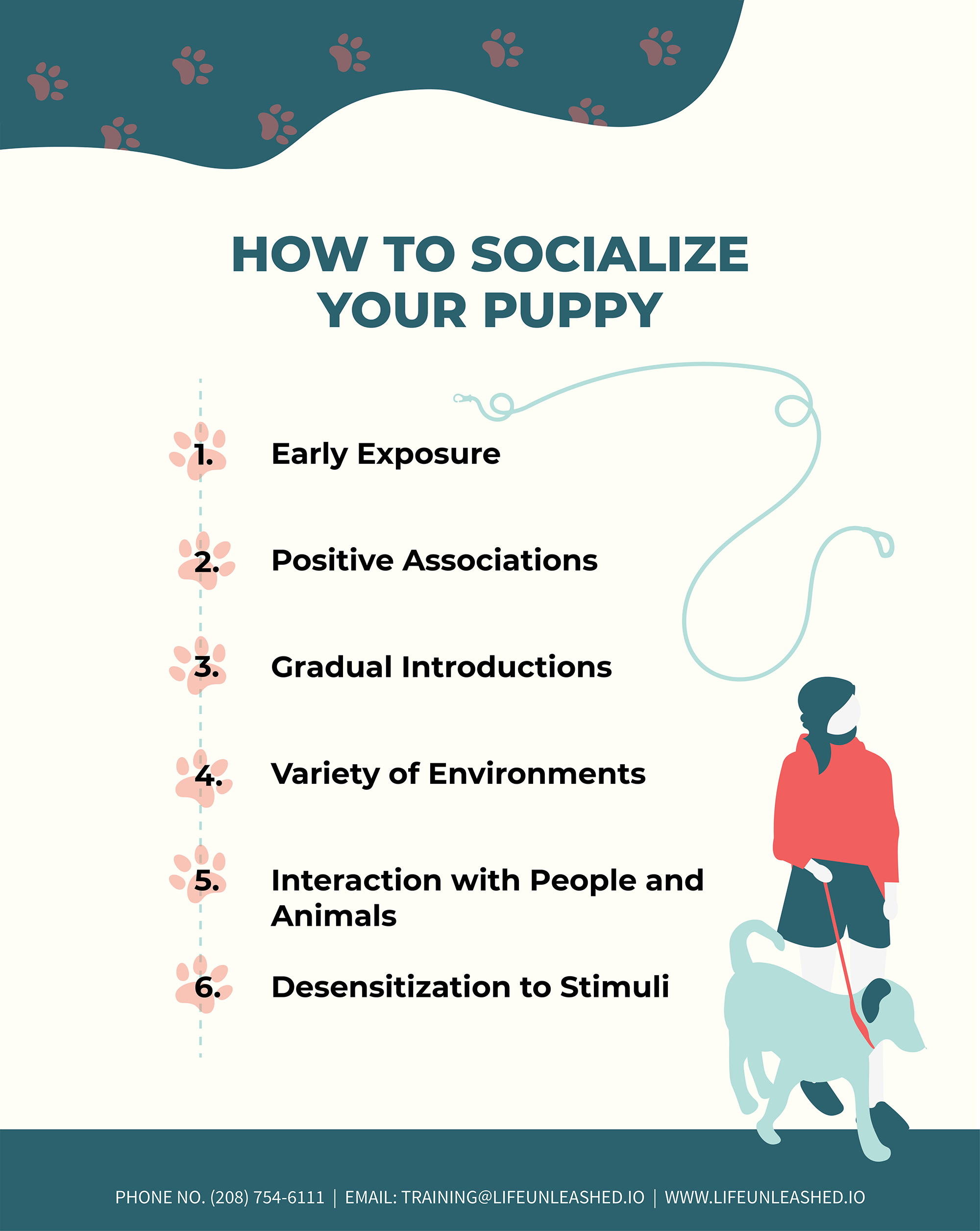
Here are key aspects of socialization as a method of puppy training:
1. Early Exposure: Socialization should begin as early as possible, ideally during the critical period of puppyhood, which is typically between 3 and 14 weeks of age. During this time, puppies are more open to new experiences and are forming lasting impressions.
2. Positive Associations: Socialization focuses on creating positive associations with various stimuli. This includes meeting different people, encountering other dogs, experiencing various sounds, and interacting with diverse environments. Positive associations build the puppy’s confidence and reduce the likelihood of fear or anxiety later in life.
3. Gradual Introductions: Introduce your puppy to new experiences gradually and in a controlled manner. Start with less overwhelming situations and progressively expose them to more challenging environments. This prevents the puppy from becoming fearful or overwhelmed.
4. Variety of Environments: Expose your puppy to a wide range of environments such as parks, streets, stores, and different types of surfaces. This helps them become adaptable and comfortable in diverse settings, reducing anxiety in new situations.
5. Interaction with People and Animals: Encourage positive interactions with various people, including children and strangers. Additionally, facilitate controlled interactions with other dogs to promote healthy social behavior. Ensure that these interactions are positive and supervised to prevent negative experiences.
6. Desensitization to Stimuli: Expose your puppy to common stimuli like car rides, grooming tools, and vet visits early on. This helps desensitize them to potentially stressful situations, making future experiences less intimidating.
Conclusion
So, let’s sum it up! Starting puppy training early sets the stage for a happy and well-behaved furry friend. Patience and consistency are very important in this adventure, making training effective and enjoyable. Remember, it’s all about redirecting their energy toward behaviors you love.
When tackling those unwanted puppy behaviors, a sprinkle of patience and positive reinforcement does wonders. And hey, if you ever find yourself in a bit of a training pickle, don’t hesitate to reach out to the pros – they’re there to help guide you and your pup to success!
So, there you have it! Your guide to a smooth training journey, filled with tail wags and ‘aha’ moments. Happy training! 🐾
FAQs about Puppy Training
When should I start training my puppy?
Training can begin as early as 7-8 weeks old. Puppies are most receptive to learning between 8 and 16 weeks, but it’s never too late to start. Consistency is crucial, regardless of your puppy’s age.
How long should training sessions be?
Keep training sessions short and positive, around 5-10 minutes for younger puppies and up to 15 minutes for older ones. Multiple short sessions throughout the day are more effective than one long session.
What are the essential commands every puppy should learn?
The fundamental commands include sit, stay, come, and lie down. These commands lay the groundwork for further training and ensure a well-behaved and obedient pet.
What training treats are the most effective?
Small, soft treats that your puppy loves work well. Use treats sparingly to avoid overfeeding, and consider using praise or affection as alternatives once the behavior is well-established.
How do I handle potty training?
Establish a consistent routine for feeding and bathroom breaks. Take your puppy outside frequently, especially after meals and naps. Reward them for successful outdoor bathroom trips, and be patient – accidents will happen.
My puppy keeps chewing on everything. What should I do?
Provide appropriate chew toys to redirect their chewing behavior. Puppy-proof your home by removing items they could harm themselves with, and supervise them closely. Consistent correction and praise for appropriate chewing can help.
What's the best way to socialize my puppy?
Expose your puppy to various people, environments, and other dogs in a positive manner. Puppy socialization classes, controlled playdates, and gradual introductions can help build a well-adjusted and friendly adult dog.
How can I stop my puppy from biting and nipping?
Puppies explore the world with their mouths, but it’s important to teach bite inhibition. Yelp or say “ouch” when they bite, then redirect them to an appropriate toy. Consistent reinforcement of this behavior helps them learn what is acceptable.
What if my puppy doesn't respond to training?
Be patient and consistent. Puppies may not immediately grasp commands, and different breeds learn at different rates. If you’re struggling, consider seeking guidance from a professional dog trainer or behaviorist.
Should I use positive reinforcement or punishment in training?
Positive reinforcement is generally more effective and builds a stronger bond between you and your puppy. Reward good behavior with treats, praise, or toys. Avoid punishment, as it can lead to fear and aggression.
How do I handle leash training?
Introduce the leash gradually, let your puppy get used to wearing it indoors first. Use treats and praise to reward them for walking nicely on the leash. Be patient and avoid pulling – encourage them to walk beside you.
What do I do if my puppy is afraid of certain things?
Gradually expose your puppy to the feared objects or situations, using treats and praise to create positive associations. Don’t force them into situations that cause extreme fear, and consult a professional if the fear persists.



